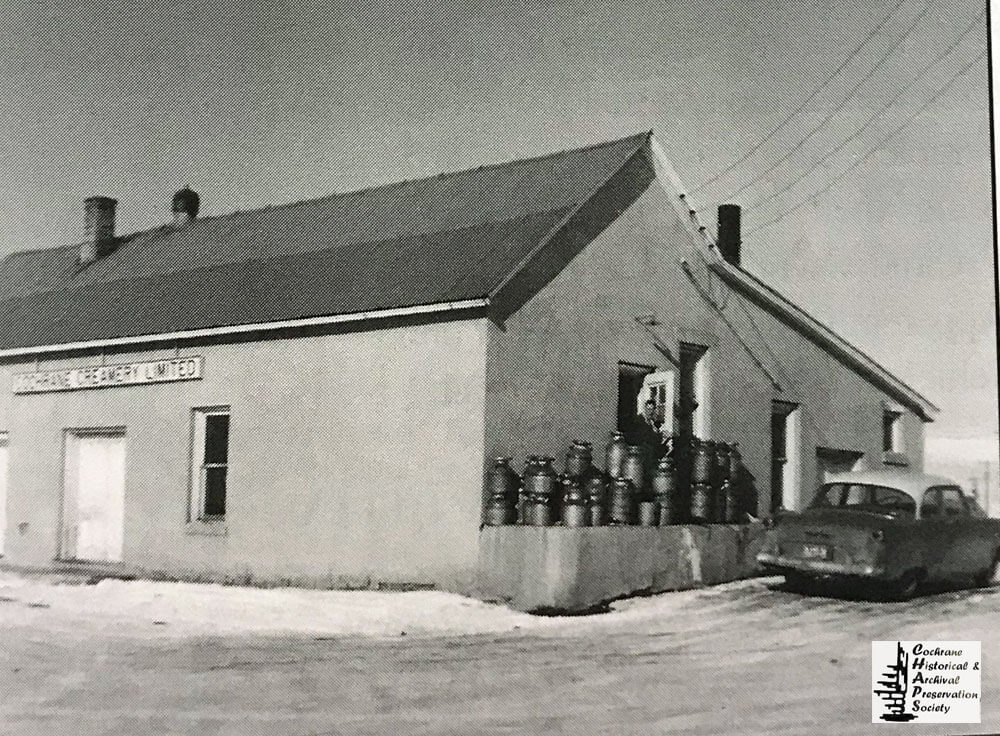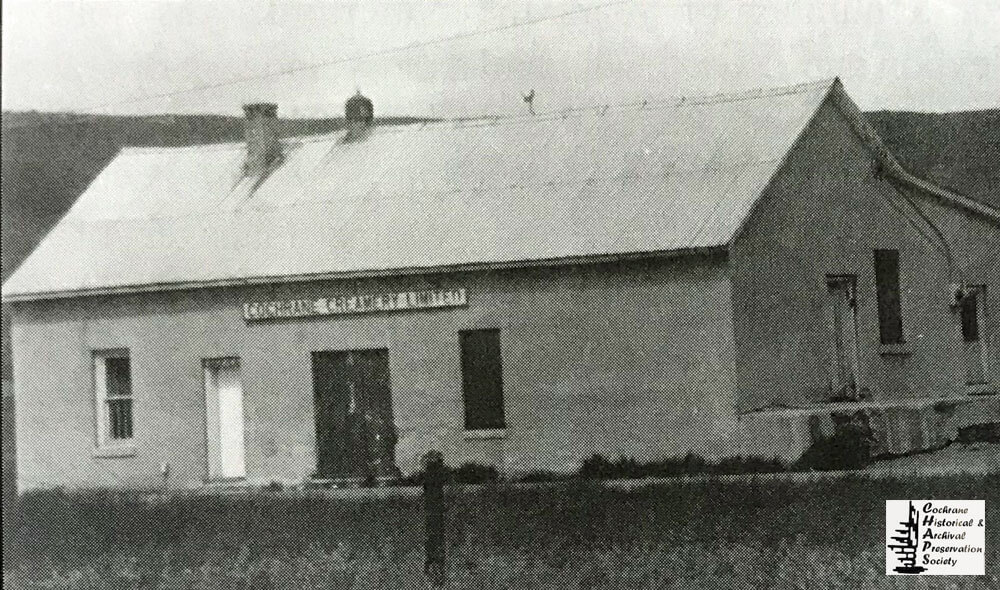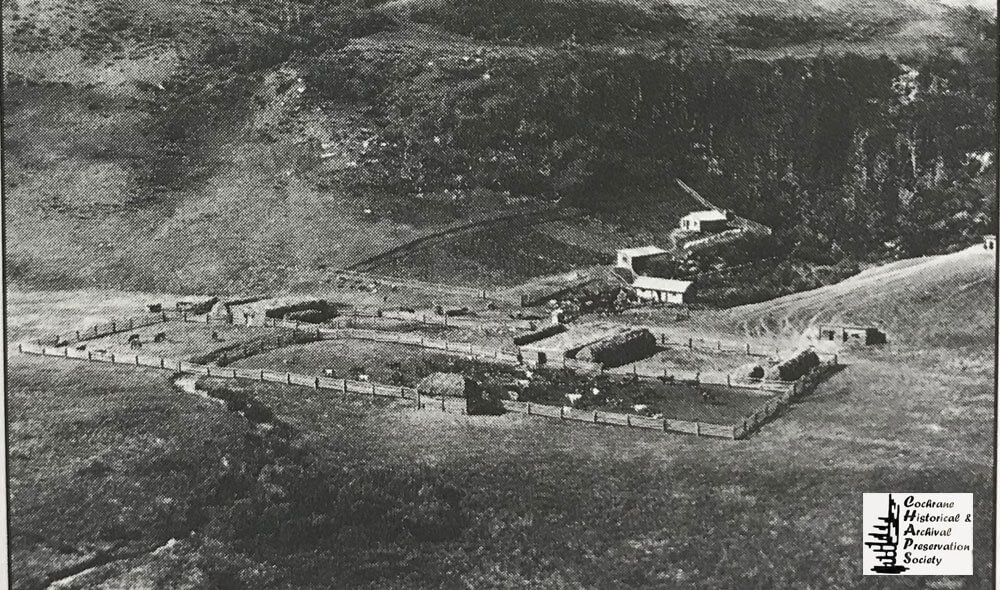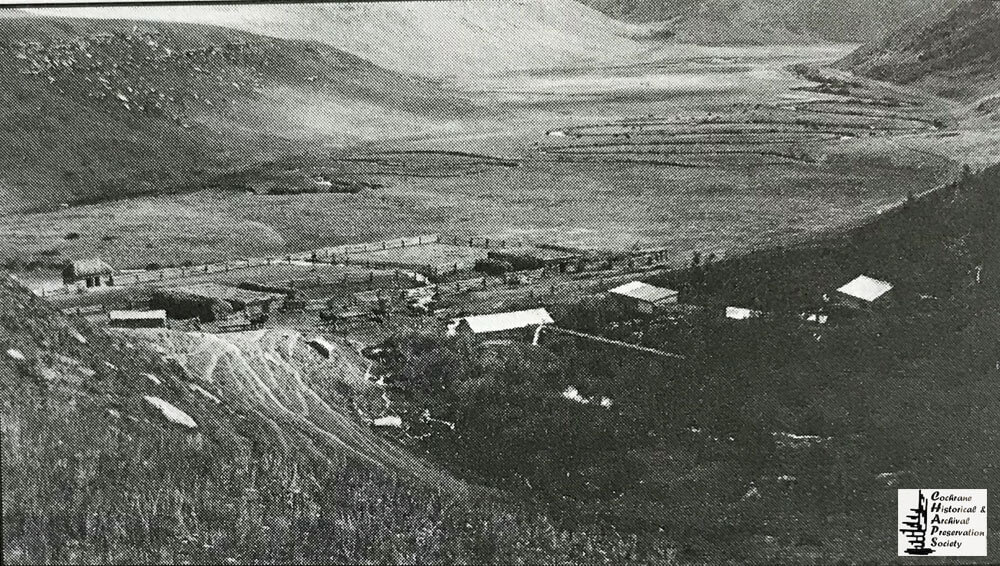Many of the stories this month have been of short term businesses. I want to finish off the month with a story about a long time land mark and successful business the Cochrane Creamery. But did you know, there was a another earlier Creamery in the area.
An 80 Year Industry By Jo Hutchinson
The availability of a steady income, however small, was one of the greatest problems faced by pioneer settlers. Frequently the shortage of cash forced men into off-farm employment, sometimes at a distance from home. This could cause great hardships for his wife and family, and often resulted in the neglect of the farm they were trying to develop.
When D.M. Ratcliffe built a creamery at the present location of Big Hill Springs Provincial Park in the 1890s, an important industry was begun in the Cochrane area. Settlers were able to eke out a steady income from milking cows and selling cream. There was a growing demand for butter, in railroad construction camps and in towns that were being established.
Difficult access to Ratcliffe’s, later Brealey’s creamery, due to the steep surrounding hills, was probably the reason for its closure, and the establishment of a creamery in Cochrane about the year 1910.
The Cochrane Creamery Association was formed by a number of farmer-shareholders. At first the creamery was on the present site of the Shell Service Station. In about 1921 it was moved west to a location on the banks of Big Hill Creek, immediately north of the 1A Highway.
It is believed that Jim Loughery was hired as manager of the Creamery when it opened. He had previously managed a cheese factory, and later a creamery, at Bottrel; presumably it closed when Cochrane’s facility was started. Mr. Loughery had a brick house built in 1910 near the west end of Main Street. Legend has it that he used to walk to Bottrel on weekends to visit his fiancée, Irene Atkinson. They lived all their married life in this house, which is still standing and has undergone renovation.
During the 1930s, the Lougherys purchased the Creamery from its shareholders. The business served a wide area; for years Mrs. Loughery’s brother, Sam Atkhinson, hauled cream from farms as far away as Bottrel and Dog Pound, while other farmers delivered it directly. There was a big stack of cream cans on the platform outside the Creamery door; each shipper had two or more cans with their name and the letters CCA painted on. When they delivered cream, they found their empty on the stack and took it home for refilling.
Most farms had poor facilities for keeping the daily accumulation of cream; some cans were hung down the well, while the odd farm was lucky enough to have a spring near the house which could be utilized for keeping the cream cool. In other cases, it just soured, in which case the grade was reduced and it was priced lower. Butter makers at most creameries had numerous anecdotes about what was found at the bottom of cream cans. However, health regulations were scanty and dubious additives such as mice or the odd lost dishcloth just added to the flavour of the ensuing butter. Regardless of occasional disturbing “finds”, the Cochrane Creamery took many awards over the years for its butter.
For a number of years, the buttermilk was sold to Beynon and Davies, who had a dairy and hog operation near the present site of the Cochrane Ranche House.
Jim Loughery died in 1938 and in 1939, Sam Peverell, a nephew of Irene Loughery, became the manager of the Creamery. He purchased it from his aunt in 1954. Sam and his wife Muriel were Cochrane residents until the Creamery was closed and sold in 1975. The last churning took place in December 1974. By then there were few area farmers who wished to ship cream, as agriculture had changed direction. Small mixed farms were no longer a means of making a living, and ranching, hay or grain operations had taken over. Another chapter in the history of the development of Alberta closed.
An interesting anecdote regarding the parking area at the Creamery is the fact that it was often filled with unlicensed vehicles during the Depression years. Farmers would bring their cream in and leave their vehicles at the Creamery while they walked into Cochrane for groceries. Apparently, the police turned a blind eye to illegally driven vehicles outside the village limits!
The First Creamery in Big Hill Country By Jon Hutchison Reprinted from Bill Hill Country
In the early 1890s, D. M. Ratcliffe established a creamery straddling the line between the NW and the NE Sec 29 Twp 26 Range 3 W5M, beside the spring-fed creek which flows into Big Hill Creek. This site is in the present Big Hills Springs Provincial Park. This creamery is believed to be the first to produce butter in what is now the Province of Alberta.
The Ratcliffe children attended school at Mitford. It is not known how long Ratcliffe operated the creamery or to what extent he built it up before selling to Brealey (Breeley) and moved to the Red Deer, Alberta area. From the records at Land Titles office, it is apparent that neither Ratcliffe nor Brealey held title to the land. The first registered owner was D. P. McDonald in 1919.
No record remains of how long Brealey operated the creamery but it must have been quite a few years, as the creek generally came to be known as Brealey Springs. It was not until years later that the name “Big Hill Springs” was substituted.
Brealey had a complete set of farm buildings and corrals as well as the creamery. A part of the stream was channelled along the hillside in a ditch to the mouth of the coulee and then down a flume to the Pelton wheel, which supplied the power for churning the butter. The clear cold water was also the refrigerant for the cream and butter. Some local help was employed.
During the time the creamery was in operation, there was no road down the Big Hill Creek valley. The butter was hauled by wagon or democrat across Big Hill Creek through a shallow rocky ford, then south and east along the lower slope of the main valley and then up a narrow dry coulee to the east. From there it was hauled to Calgary, or possibly Mitford, and later Cochrane. Almost no trace of the old trail remains.
From the northwest there was a trail of sorts that curved steeply down the point of the hill There is a story of one farmer, bringing his cans of cream by team and democrat down the tricky trail, who had the misfortune to have his rig tip over. One can imagine the unfortunate driver, himself dumped down the hill, still clinging to the lines, and trying to keep the spooked team from running away with what was left of his democrat, while his hard-earned cream went spilling down the hill.
Until the mid-1940s, some evidence of the old creamery was still in existence. Part of the old ditch and parts of old building foundations could still be seen. Some of the sandstone slabs, part of the barn floor, were also visible.
It seems a shame that the old name “Brealey Springs” was dropped. The name “Big Hill Springs” is not really correct. It is located 5 or 6 miles from the Big Hill. Big Hill Creek got its name from the fact that it enters the Bow Valley at the foot of the Big Hill.
The Cochrane Creamery Association and The Cochrane Creamery By James Whittle
On Saturday, March 13, 1909, Mr. C. Marker, the provincial Dairy Commissioner, held a meeting in Cochrane to provide information about the establishment of a creamery. However, it was not until late in 1910 that things got started in earnest. At that time, the firm of Marlatt & Clark of Fort Atkinson Wisconsin was building a creamery at Cardston. At the invitation of the Cochrane Board of Trade, the firm surveyed farmers and dairymen of the Cochrane district in December 1910 and determined that there was sufficient interest, shareholders willing to put up capital for construction, and farmers with cows to supply the milk. A site was to secured at the west edge of town, at what is now the northwest corner of 1st Street and 5th Avenue. A well was dug, and on Monday, March 20, 1911, construction began. The completed building was opened for inspection i on Monday, May 8, 1911. Meanwhile, The Cochrane I Creamery Association was organized under the provisions of the provincial Dairymen’s Act, the necessary declaration having been filed on April 20, 1911. The first Board was elected at a meeting of the shareholders on May 22, 1911. It consisted of J. Cook, President, N. Phelps, Vice-President, J. A. Campbell, Treasurer, G. A. Stringer, Secretary, and J. C. Craig, W. Steel, W. Milligan, and S. Spicer, Directors.
The Board had difficulty in arranging for operating funds, with the result that the Creamery did not open for business until the middle of April 1912. By that time, a new Board of Directors was in control, having been elected at the annual meeting of shareholders on February 10. 1912: J.G. Tweed. Earle Whittle. J. A Campbell, J. Cook (President), G. Claxton, D. McEcheren, and S. Spicer. The Creamery was briefly under the management of Mr. L. Pilon, but on May 23 The Cochrane Advocate announced that Mr. J. W. Loughery had taken over. Despite a promising start, the first season was a disaster. A major customer, The Alberta Ice Cream Co., went bankrupt, some produce shipments were not paid for, and some patrons went unpaid for cream delivered. The Creamery closed for the winter at the end of September and did not open for business in 1913.
In 1914, a fresh start was made. The annual meeting of shareholders on Tuesday, February 3, 1914, elected a Board consisting of Earle H. Whittle, President, J. Campbell, Vice-President, J. Cook, Secretary, and J. Elder and D. Morrison, Directors. Patrons agreed to accept 50 cents on the dollar in settlement of outstanding accounts, and the Creamery opened for business on
May 18, 1914. The manager for the 1914 and 1915 seasons (the Creamery closed in the winter of 1914-15) was George Neilson, apparently a capable, conscientious creamery man who placed the operation on a solid footing. He aimed to create a steady market by giving the consumer a better grade of butter than they could obtain elsewhere. His high standards raised questions and complaints from local cream producers, but in the issue of September 8, 1915. The Cochrane Advocate reported that Cochrane Creamery butter had won first prize and a gold medal at the Brandon fair.
Two significant events took place in the fall of 1915. At the beginning of October, George Neilson resigned and Jim Loughery returned, beginning his 20-year tenure as manager. And the Creamery commenced year-round operation, remaining open throughout the winter of 1915-16, and continuously thereafter. A cheque to Sam Spicer dated February 20, 1919, reproduced in Big Hill Country, representing his “2nd Creamery Dividend and Bonus,” indicates that by that time the operation was financially secure.
The supply of water at the Creamery site soon proved inadequate, and a second well, drilled in February 1917, didn’t solve the problem. So it was decided to move the Creamery to a site west of town, on the east bank of Big Hill Creek. Big Hill Country records that this was Bob Beynon’s “first big carpenter’s job” after he came to Canada in 1920. The move probably took place in the winter of 1920-21, for, at a meeting of the Cochrane Social and Athletic Club on September 14, 1921, the Creamery Association was able to offer the use of the old Creamery site” for the building of a skating rink.
During the Great Depression in the 1930s, the steady income from the Creamery was sustaining for many farm families in the area. But many shareholders saw better use for their money and sold out to Jim Loughery. Earle Whittle, still the president of the Cochrane Creamery Association, died on November 8, 1936, and Jim Loughery died about the same time. Loughery’s widow Irene emerged as the sole owner of the Creamery. The Association passed from the scene, and the Creamery operated from that point onward as a private business under the name Cochrane Creamery Limited.
Sydney Reed had joined the staff of the Creamery in 1935 as a butter maker, working with Jim Loughery. When Loughery died, his widow Irene first engaged her brother Sam Atkinson as manager. But Atkinson wished to return to his farm at Bottrel, so, in 1939, Sam and Muriel Peverell moved to Cochrane, and Sam Peverell replaced Sam Atkinson as manager. Sam Peverell was Irene’s nephew, the son of her sister Elizabeth. Peverell and Reed operated the business through the war years and after. When it became apparent that Peverell planned to take over the Creamery (which he did in 1954, purchasing it from his Aunt Irene) Reed moved in 1953 to the creamery in Okotoks, where he worked as butter maker until his death in 1958.
Sam continued to operate the creamery with his son Brian and they collected many awards for their butter, known quite widely. CCC Butter was the consumer’s choice.
The churns of the Cochrane Creamery ceased to turn around 1970, and Peverell developed a domestic milk supply and delivery business. In December 1974, he sold the building and business to Mel Roland, who in turn sold out to the provincial government, to round out the boundaries of the Cochrane Ranche Provincial Historic Site, which opened in May 1979.
The Creamery building was demolished to make way for the Park. But the Cochrane Legacy Statue unveiled on June 17, 2003, the one-hundredth anniversary of the incorporation of the town, includes a reproduction of a Cochrane Creamery Association cream can to serve as an enduring reminder of an institution that for sixty years contributed in an important way to the economy of the Cochrane District.




